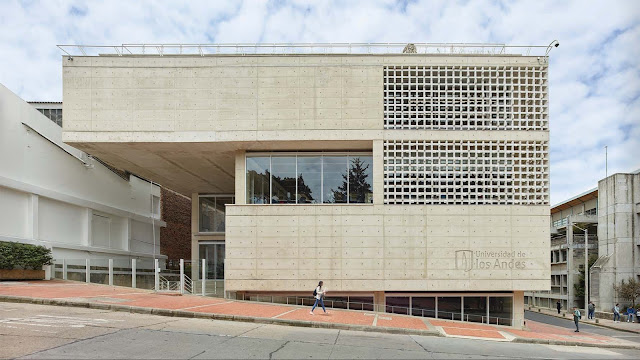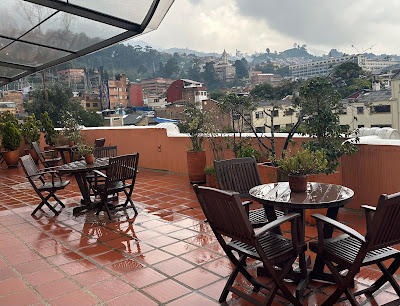March 17, 2023
Our second destination after Cartagena was the capital city of Colombia, Bogotá.
I got up at 4:30 AM to take a shower and repack so that I'd be ready for our return trip to the Cartagena Airport. It is a very small facility--essentially one large room. We got there about an hour before our flight to Bogotá, and there wasn't much to do. Our flight was pretty short, maybe 1 hour 25 minutes, but it would have taken almost 20 hours to drive it because of the roads and the terrain between the two cities.
On our arrival in Bogotá, we were picked up by a non-English speaking man and a driver named, of all things, Judy. They took us to our hotel, the Hotel Casa Deco:
. . . but it was still pretty early in the morning and the room wasn't ready, so we left our luggage and headed out with our guide, a woman whose name we never really got. She turned out to be a good guide, although she spoke a bit too fast and was harder to understand than Carolina, our fantastic guide in Cartagena, and she often misinterpreted our questions. I think if she had just slowed down, communication would have been a lot better.
The first place we visited was Monserrate, the tallest mountain in the city and therefore, like yesterday's Mount la Popa in Cartagena, a great place to begin because it offers a 360° view of the city. Unlike the lower elevation of Cartagena's viewpoint, however, Monserrate is 10,341 feet above sea level and a 2,000 foot elevation gain from bottom to top.
Pilgrims make their way to the top of the mountain on foot, but we opted for a funicular ride. Our guide had purchased "fast pass" tickets, so we didn't have to wait in what was a very long line, which saved a ton of time. The funicular had four sections with maybe 20 passengers in each, all standing.
You can get an idea of how steep it is from these photos Savannah took:
At the very top of the walk is a cathedral and some shops, where Savannah bought a Colombian flag and a Colombian flag-design knit scarf to hang on her bedroom wall.
A group of schoolchildren were at the top of the mountain and started waving and saying hi to us, so we responded and they all began to chatter "How are you?" "What is your name?" and other English 101 phrases.
We went inside the church, which was pretty plain for as prominent as it is--we could see it from all over the city.
I was moved by a sculpture outside the church of a homeless man sleeping on a bench. When I looked closer, I saw that it was entitled Homeless Jesus by the Canadian artist Timothy Schmalz. It is one of 100 casts of the sculpture found around the world . The original sculpture was installed at the University of Toronto in 2013. It shows a figure sleeping on a park bench, its face and hands covered.
We were fortunate to be the first ones in line for the funicular ride down. We chose the very front of the car. Here is Savannah's video of the ride.
We decided to walk to the hotel to drop off Bob's camera, which he had brought along just in case he saw some interesting birds on Monserrate. On our way we passed by the home of Simon Bolivar. The house and gardens were a gift to him from the people of the area as thanks for liberating them from Spanish rule. Though not his principal residence, Bolivar did stay here whenever he visited Bogotá. Here is our guide in front of the house:
We were just going to peek through the gate, but the guard said admission was free because the ticket office was closed while a staff member was temporarily gone. We took advantage of the free admission and went inside.
The house is beautiful. There are perhaps eight large rooms, very elegantly furnished, and a separate building for the kitchen. Even more spectacular are the extensive gardens, which are full of a wide variety of plants and trees, many of which were in bloom when we were there. I took lots of photos--and like my photos on Montserrate, they never made it to the cloud before my phone was stolen.
We had continued on our way, passing through the campus of the University of the Andes, a private research university that is the top university in Colombia and #5 in Latin America. It has a very competitive admission process. It isn't exactly a place you expect to be robbed, but This Is Where It Happened.
We were walking past the building above. There were many students milling about, and one bumped into me fairly hard and then turned and walked quickly away. He was clean-cut and well-dressed, but it struck me as odd, and almost immediately I began checking my belongings. I was wearing a cross-body purse, and I usually put my cell phone in the deep side pocket. It took a few minutes of rummaging through all the pockets and the inside of the purse to ascertain that my three-week-old $1200 iPhone14 was not there. By then, the young man was long gone. We started walking in the direction he had gone, but I don't think I would have recognized him if I had seen him as I only got a vague impression of him when he collided with me.
It was devastating to lose my phone in general, but specifically on this trip when I was using it for my camera and it was my contact with the world. I had already had texts, emails, and calls about various community- and work-related things, and now I had no access to any of that. I felt like I had lost a body part.
Savannah immediately reached out to her mom to see what to do. We tried calling Apple and then Bob's work, but we couldn't get a call to go through. Sav texted her dad and told him top call us, and when he did Bob had him call his work to tell them to call Verizon and get them to lock the phone. (About three hours later, when I was checking my personal email on Bob's phone, I saw a notification that someone had requested the password to unlock my phone. I had at least two more of those, the last one coming from somewhere in the Midwestern United States!)
Well, we had done all we could and had to move on.
While all this phone action was going on, we had lunch at a fun place on campus. We started with some fruit juices "with milk," which means they were essentially milk shakes, and a cup of salpicon similar to what we had in Cartagena.
I ordered a soup Bogotá is known for: Ajiaco Colombiano. It has chicken and three kinds of potatoes, and it comes with a separate plate of rice, corn on the cob, and avocado and little cups of cream and capers that you stir into the soup. This photo doesn't do it justice. (I was still recovering from the phone theft, but this is when I took over Bob's phone for the rest of the trip. Bless his heart.)
We had more than we could eat, and I was moved and impressed when our guide took our leftover food and found someone on the street to give it to.
After lunch we walked the last few blocks to the hotel. Our room was ready, so we took our bags up to the top floor (4th) via the stairs as there was no elevator. Bob was having trouble with his knees, maybe because we sat on the very back row of our last flight and had no legroom. The stairs were hard on him.
Our room was very large but with a strange layout. There was a small room behind the main bed with shelves and a mirror. There was a tiny sink at the end of the hall. The toilet was its own room, and next to it was a room of the same size that was the shower, which had a partially frosted glass door. Anyone who showered could be seen from the beds. However, there was also a sitting area with chairs, and Sav sat with her back to the shower while we used it and vice versa.
Running the length of the outer wall was a very nice deck with 4-5 tables and chairs around the tables. It could be accessed from our room, but also from the hall outside our room. It had many large windows of frosted glass with sheer purple "drapes" on the sides. At night, the deck was fully lit, and of course that light came through our windows, making our room very light. It was super annoying.
Anyway, after freshening up a bit, we went back out with our guide. We walked through Old Town and discovered that like Cartagena, Bogotá has some fun street art:

















.jpg)




.JPG)
.JPG)



.JPG)
.JPG)
.JPG)
.JPG)
.JPG)
.JPG)
.JPG)
.JPG)
.jpg)
.JPG)
.JPG)
.JPG)
.JPG)
.JPG)
.JPG)
.JPG)
.JPG)
.JPG)
.JPG)
.JPG)
.JPG)


.JPG)

.JPG)
.JPG)
.JPG)
.JPG)
.JPG)
.JPG)
.JPG)
.JPG)
.JPG)
.JPG)
.JPG)
(Bob) What an interesting day. From the seaside city of Cartagena, old fashioned, low key, poor; to the mountain town of Bogota, modern, wealthy(ier), huge city. There was lots to like, kind of, but really nothing to love. Botero was very fun, the funicular ride and mountain views were wonderful, our hotel was unusual, but a long slog up steep stairs, lots of rain. Definitely colored by the stolen cell phone. I think my favorite thing of the day was eating mangosteen from a street cart (which maybe you have not gotten to): my favorite fruit of the trip, which is saying something, and maybe my favorite fruit period. We were supposed to have a fruit tasting excursion which did not happen (the mangosteen happened because I want to the cart) and admittedly our time was crushed by the mishap. That missed fruit excursion is probably my biggest regret of the trip - I loved the variety and quality of fruit in Colombia. I would go back just for the fruit. Colombia has a lot to love.
ReplyDeleteMangosteen and fruit carts coming up in next post.
Delete